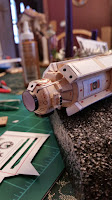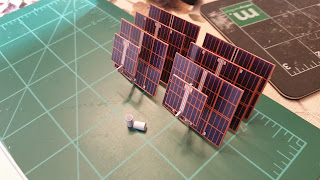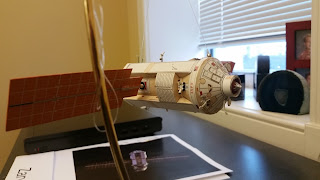The first module, Zarya (Заря́), which means "sunrise" in Russian, has great significance as ushering in the dawn of a new era of international cooperation in space exploration.
Zarya, also known as the Functional Cargo Block (FGB), was launched on November 20, 1998 aboard a Russian Proton rocket from the Baikonur Cosmodrome Site 81 in Kazakhstan to a 400 km (250 mi) high orbit. The module was designed for a lifetime of at least 15 years. The module provided initial power and propulsion functions for the station. Zarya's construction was funded by the United States. The module was built at the Khrunichev State Research and Production Space Center (KhSC) in Moscow. Zarya's control system was developed by the Khartron Corp.
Zarya is part of the free ISS Russian segment kit offered by AXM. The build consists of 5 pages of parts. The accompanying instruction manual provides fairly good assembly directions with many reference photos. An addendum to the instructions includes directions for placement of the Kurs docking navigation antennas and panels on the aft section of the module.
I started by build by first assembling the module's main body cylinder and end caps.
- Use a pen or pencil to help you slowly curve your part into a cylinder. Be patient and take your time. Don't force the curving process or you will most likely end up with longitudinal creases in the surface.
- This particular assembly uses a connector tab that is glued to the backside of each edge so that the edges are flush with one another when joined, avoiding a noticeable overlap on the resulting seam. Not all part joins take this approach. However, I have found that you can cut the connector tab off and glue it to the backside in most all cases in order to always achieve a flush join, helping to minimize visible seams and improve on realism.
- Many curved parts have connector tab "teeth". One important paper modeling word of advice to pass along here - "scoring". Scoring involves making an indentation on the back side of a paper bend in order to achieve a clean crease in your paper that follows the intended crease line. Use an awl, dull needle, or backside of an exact-o knife to score the paper, making sure not to cut into the material, but rather depress/indent it. Again, take your time and use a straight edge to ensure a true score line that follows the intended tack.
Using a liberal amount of glue, I mounted a magnet on the inside of the forward edge of the module cylinder at the module's position III (aka zenith). I then glued on the cylinder ends. At this point I ran into my first challenge: gluing of the elongated fuel tanks to the module cylinder. These parts have odd angles. The white glue tabs on each tank must align precisely with box outlines on the module cylinder. The combination of odd angles on the tanks along with the curvature of the cylinder made alignment of the tabs on the box outlines a bit tricky, to say the least. I was able to affix the tanks, but some glue was dispersed outside of the coverage areas. Luckily, the areas were inconspicuous or covered by other parts not yet attached (pump panels).
The aft portion of Zarya consists of two cones butted against one another. Assembly of this section presented my second technical challenge. The cones are connected by a thin cylinder having "teeth" on both sides. My difficulty involved precise alignment of the outer edge of each cone against the edge of the cylinder while simultaneously trying to deal with the glue applied to the teeth. Little time was available to position the cone before the glue adherence prevented adjustment. I was able to get the aft-side cone positioned correctly. However, I ran into problems on the fore-side cone, which resulted in a very slight crooked alignment against the cylinder edge. I initially thought about pitching the part and starting over. However, I decided instead to produce another copy of the fore-side cone, printed on regular paper and attach it over the mis-aligned cone. It worked and the crooked seam was covered! I glued another magnet on the inside of the structure along the cylinder area at the zenith point and then proceeded to glue the structure to the main module cylinder.

I then affixed the aft covering.
I moved back to the module's forward section and fabricated and attached the forward steering jets propellant compressor, the conical section that connects the module main body to the forward docking unit, conical section connector panels, forward fuel tank protective shields, and protective shield targets.
I then set to work on adding the aft steering jets located on the port and starboard sides. The build rendition of these components consists of a platform with a 2 dimensional rendition of the steering jets affixed atop to platform.
I wanted a better rendition. Drawing again from my experience with fabrication of RCS thrusters on the LEM portion of my Saturn V build, I decided to fabricate steering jets to achieve a true 3 dimensional rendition using bamboo skewers.
I repeated the process for fabrication of the forward steering jets. I initially made the jet nozzles a little too long and had to cut them down a bit in order to achieve the correct perspective.
 |
| Before |
 |
| After (Starboard) |
 |
| After (Port) |
I then built the forward Androgynous Peripheral Docking System (APDS) and aft active/hybrid docking assemblies. Both assemblies are not glued, to accommodate future connection to Pressurized Mating Adapter #1 (PMA-1) (forward), and Zvezda (aft) as these modules are added to the configuration.





































